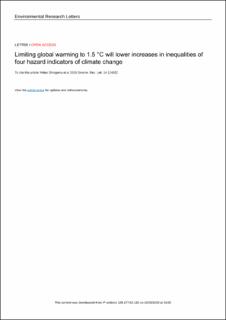| dc.contributor.author | Shiogama, Hideo | |
| dc.contributor.author | Hasegawa, Tomoko | |
| dc.contributor.author | Fujimori, Shinichiro | |
| dc.contributor.author | Murakami, Daisuke | |
| dc.contributor.author | Takahashi, Kiyoshi | |
| dc.contributor.author | Tanaka, Katsumasa | |
| dc.contributor.author | Emori, Seita | |
| dc.contributor.author | Kubota, Izumi | |
| dc.contributor.author | Abe, Manabu | |
| dc.contributor.author | Imada, Yukiko | |
| dc.contributor.author | Watanabe, Masahiro | |
| dc.contributor.author | Mitchell, Daniel | |
| dc.contributor.author | Schaller, Nathalie | |
| dc.contributor.author | Sillmann, Jana | |
| dc.contributor.author | Fischer, Erich | |
| dc.contributor.author | Scinocca, John F. | |
| dc.contributor.author | Bethke, Ingo | |
| dc.contributor.author | Lierhammer, Ludwig | |
| dc.contributor.author | Takakura, Jun'ya | |
| dc.contributor.author | Trautmann, Tim | |
| dc.contributor.author | Döll, Petra | |
| dc.contributor.author | Ostberg, Sebastian | |
| dc.contributor.author | Schmied, Hannes Müller | |
| dc.contributor.author | Saeed, Fahad | |
| dc.contributor.author | Schleussner, Carl-Friedrich | |
| dc.date.accessioned | 2021-06-17T08:29:58Z | |
| dc.date.available | 2021-06-17T08:29:58Z | |
| dc.date.created | 2019-12-20T15:45:11Z | |
| dc.date.issued | 2019 | |
| dc.identifier.issn | 1748-9326 | |
| dc.identifier.uri | https://hdl.handle.net/11250/2759896 | |
| dc.description.abstract | Clarifying characteristics of hazards and risks of climate change at 2 °C and 1.5 °C global warming is
important for understanding the implications of the Paris Agreement. We perform and analyze large
ensembles of 2 °C and 1.5 °C warming simulations. In the 2 °C runs, we find substantial increases in
extreme hot days, heavy rainfalls, high streamflow and labor capacity reduction related to heat stress.
For example, about half of the world’s population is projected to experience a present day 1-in-10 year
hot day event every other year at 2 °C warming. The regions with relatively large increases of these four
hazard indicators coincide with countries characterized by small CO2 emissions, low-income and high
vulnerability. Limiting global warming to 1.5 °C, compared to 2 °C, is projected to lower increases in
the four hazard indicators especially in those regions. | en_US |
| dc.language.iso | eng | en_US |
| dc.publisher | IOP Publishing | en_US |
| dc.rights | Navngivelse-DelPåSammeVilkår 4.0 Internasjonal | * |
| dc.rights.uri | http://creativecommons.org/licenses/by-sa/4.0/deed.no | * |
| dc.subject | climate change | en_US |
| dc.subject | climate model | en_US |
| dc.subject | Paris agreement | en_US |
| dc.subject | inequality | en_US |
| dc.title | Limiting global warming to 1.5 °C will lower increases in inequalities of four hazard indicators of climate change | en_US |
| dc.type | Journal article | en_US |
| dc.type | Peer reviewed | en_US |
| dc.description.version | publishedVersion | en_US |
| dc.source.journal | Environmental Research Letters | en_US |
| dc.source.issue | 14 | en_US |
| dc.identifier.doi | 10.1088/1748-9326/ab5256 | |
| dc.identifier.cristin | 1763485 | |
| dc.relation.project | Norges forskningsråd: 261821 | en_US |
| dc.relation.project | Notur/NorStore: ns2345k | en_US |
| dc.relation.project | Notur/NorStore: ns9082k | en_US |
| cristin.unitcode | 7475,0,0,0 | |
| cristin.unitname | CICERO Senter for klimaforskning | |
| cristin.ispublished | true | |
| cristin.fulltext | original | |
| cristin.qualitycode | 1 | |

